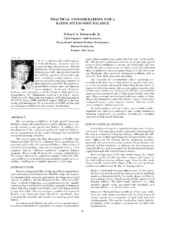| dc.contributor.other | Turbomachinery Symposium (7th : 1978) | |
| dc.creator | Bulanowski, Edward A. | |
| dc.date.accessioned | 2017-10-05T14:55:11Z | |
| dc.date.available | 2017-10-05T14:55:11Z | |
| dc.date.issued | 1978 | |
| dc.identifier.uri | https://hdl.handle.net/1969.1/163779 | |
| dc.description | Lecture | en |
| dc.description | Pg. 87-94. | en |
| dc.description.abstract | The increasing availability of high speed balancing facilities requires the manufacturer and/or ultimate user to seriously consider a rates speed rotor balance. In addition, the development of the "influence coefficient" method of balancing as a complement to the modal technique has established increased balancing reliability. The present paper develops the aspects of flexible rotor balancing which should be evaluated when considering the necessity and benefits of a rated speed balance. Three classes of industrial turbomachine rotors are investigated using a "rotor response" and an "influence coefficient" computer balance program. These results illustrate the concepts established in the analysis and present a practical example of how the influence coefficient and modal balancing methods complement one another, resulting in a complete approach to balancing. | en |
| dc.format.medium | Electronic | en |
| dc.format.mimetype | application/pdf | |
| dc.language.iso | en | |
| dc.publisher | Texas A&M University. Gas Turbine Laboratories | |
| dc.relation.ispartof | Proceedings of the 7th Turbomachinery Symposium | en |
| dc.subject.lcsh | Turbomachines | en |
| dc.title | Practical Considerations For A Rated Speed Shop Balance | en |
| dc.type.genre | Presentation | en |
| dc.type.material | Text | en |
| dc.identifier.doi | https://doi.org/10.21423/R19D4Q | |


